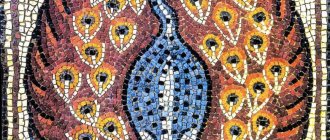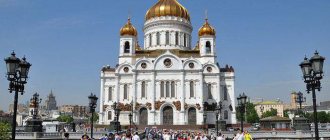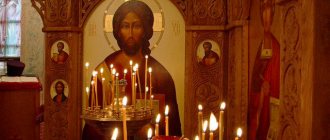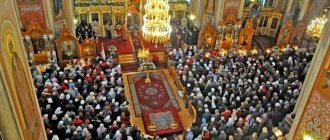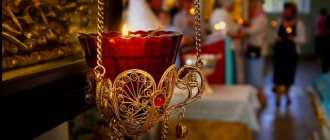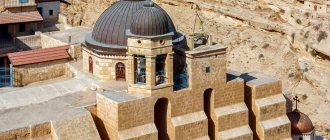It is simply impossible to imagine a shepherd, pilgrim or patriarch without this item. And the rulers of the past could not do without it, although their need for it was symbolic. We are talking about a staff - a symbol of power, faith and magic.
The famous King Oedipus, being a simple youth, walked to the gates of the city of Thebes, but the Sphinx blocked his path and asked a riddle: “Who walks on four legs in the morning, on two during the day, and on three in the evening?” The one who did not know the answer was torn apart by the Sphinx with his claws. But Oedipus was resourceful: “This is a man: as a baby he crawls on all fours, then he walks on two legs, and as an old man he leans on a staff.”
Notes on the symbolism and history of church utensils. Bishop's staff
The pommel of the staff of St.
Peter Metropolitan of Moscow The liturgical practices of the Orthodox Church have been formed over thousands of years, absorbing meanings, symbols and images from different eras and cultures. The simplicity and heroism of the first centuries of Christianity, the exquisite solemnity of Byzantium, and the strict prayerful joy of Ancient Rus' were combined in a bouquet of spiritual aromas that has no equal on earth.
Whatever item of liturgical utensil we look at, it will tell us more than one story. Many of these objects carry images that are archetypal, common to cultures that are very distant from each other. A crown is a sign of triumph and victory. The bowl is a symbol of unity and at the same time - fate. The staff is an attribute of strength and power.
The bishop's staff is a shepherd's staff, an anchor, a control tool, and a weapon of defense. This is a burden of duty and support on the way, a measure that does not allow you to go astray, and a sign of spiritual wisdom. This image contains the idea of power as the ability to stand firmly on your feet, follow the right path and lead followers, drive away and defeat opponents.
In ancient images of Christ the Good Shepherd, we see in the hands of the Savior a shepherd’s staff with a rounded handle. Most likely, the apostles also carried out their preaching journeys with staves in their hands. And, probably, even then a symbolic parallel of these staves with the rod of the Old Testament high priest arose.
“Apple” - thickening on the staff
Nowadays, the Russian Orthodox Church has developed a traditional form of the bishop's staff, which has several main variations. The upper part of the bishop's staff, used during divine services, is certainly topped with a cross mounted on a spherical “apple.” This “apple” with a cross distinguishes the attribute of the episcopal rank from the staff used by the abbots of monasteries. The staff of the wand, as a rule, is also decorated with rounded thickenings - “apples” or flat bridges - “rims”. During non-liturgical times, the bishop uses a simple-shaped staff, the handle of which does not have a crossbar. As a rule, wands are made of wood, most often dark. Liturgical (and sometimes everyday) bishop's staffs are decorated with handles and plates made of metal, most often made of silver.
Today, three main forms of the liturgical bishop's staff are used. The most ancient of them are with a T-shaped handle and with a handle, the ends of which are slightly rounded and lowered down. These forms probably came to Rus' from Byzantium. The most impressive form is the staff, the ends of the handle of which grow into images of snakes raising their heads. It appeared in Russia in the 17th century.
During the enthronement of His Holiness the Patriarch of Moscow, he is solemnly presented with the staff of St. Peter, Metropolitan of Moscow - as a sign of the continuity of spiritual power. Saint Peter played a key role in the formation of the Moscow principality: it was he who predicted the rise of Moscow to Grand Duke John Kalita, blessed the construction of the stone Assumption Cathedral in the Kremlin, and transferred the metropolitan see from Vladimir to Moscow. The saint's staff is a significant relic of the Orthodox Church. This octagonal wand, carved from dark wood, is decorated with a silver-gilded handle with slightly rounded ends. Let us note that the staff of St. Peter, made in the 14th century, does not have a cross crowning it. But from its handle to the shaft descend plates with the Calvary Cross and the instruments of the Passion of Christ carved in silver. This image eloquently speaks of the significance of the bishop’s service as bearing the cross and at the same time reminds us that the bishop carries out his service according to the grace given to him by Christ. The rounded ends of the handle represent an anchor - one of the key images of Christian symbolism, a sign of firmness in faith and spiritual prudence.
Staff of St. Stephen of Great Perm
The bishop's staff of St. Stephen of Perm, who, like St. Peter, lived in the 14th century, also has a form similar to the staff of St. Peter. Saint Stephen, a missionary who converted half-wild Perm Zyryans to the Orthodox faith, walked with a simple staff, which he personally made from light larch. Through the prayers of the saint, this staff became miraculous: with its touch Saint Stephen destroyed the idolatry. In this hagiography we see another symbolic meaning of the bishop’s staff - as a spiritual weapon, an instrument through which Divine grace acts. How can one not recall here the ancient prophet Moses, who, by the will of God, brought water out of a stone and divided the thickness of sea water in two with the touch of a staff. The fact that these actions are carried out not just with a hand, but with a rod, contains a spiritual meaning: the messengers of God act not on their own, but by the power that was given to them from above along with the call to serve.
After the death of Saint Stephen, his staff stood near the tomb of its owner, who was buried in Moscow, in the Church of the Savior on Bor. As a sign of reverence for the saint, the staff was decorated with finely crafted elk antler carvings depicting scenes from his life. In 1612, the relic was taken away by the Poles who occupied the Russian land. But the Lord preserved the shrine and more than two hundred years later - in 1849 - it was accidentally discovered in one of the churches in Lithuania, identified by a Church Slavonic inscription and returned to the Fatherland. The staff was transferred to Perm, where it was placed in the cathedral. There he enjoyed popular veneration until 1918, when the shrine was requisitioned by the Soviet government. Nowadays, the staff is in the Perm Museum of Local Lore, from where it is sometimes taken out for worship by believers.
Staff of St. Dimitry of Rostov
Shepherd of the human flock
The need to cover considerable distances in open areas forced man to use a long stick. It not only served as a support when walking, but also helped to fight off an enemy or wild animal. It is logical that the staff became an integral companion of all wanderers. When man tamed domestic animals, shepherds also adopted the staff. It served them not only as a means of support when walking, but also helped to urge and herd sheep. And in order to isolate the desired individual from the herd, the shepherds bent the upper end of the staff, giving it a hooked shape. The concept of “shepherd-flock”, which implied a shepherd and a flock, became fundamental not only for many religions, but also for rulers. This metaphor first appeared long before Christianity. In the Sumerian kingdom, which arose in the 4th millennium BC, one of the king’s regalia was a shepherd’s staff, completely devoid of precious jewelry. Sumerian rulers believed that, made from sacred wood, the staff gave the owner the same power over others that a shepherd has over his sheep. In Ancient Egypt, the staff was one of the symbols of the sun. The Egyptians believed that when the daylight hours shortened, the sun could not rise high, and therefore it needed to be supported with a support - a staff. The day of the autumn solstice here was considered the birthday of the Sun-Staff. Just like the Sumerian rulers, the pharaohs considered the staff to be their regalia. The famous wasa, a long staff with a forked end and a pommel in the form of the head of the animal god Set, terrified his subjects. Uas symbolized the fight against dark forces, whose ruler was the god Set. The Egyptians believed that wasa helped the dead in the afterlife, and was often depicted on the walls of tombs. In addition, the priests taught that the firmament rests on four pillars, similar to the wasa staff. The staff was no less significant in the life of the ancient Greeks. So, the god of the seas Poseidon had a staff in the form of a trident. And the “god of all gods” - Zeus - knocked out thunder and lightning with his staff. No less interesting is the legend about the staff of the ancient god of medicine, Asclepius. One day, the king of Crete, Minos, died his beloved son. The saddened king called Asclepius to revive the young man. Along the way, a snake entwined the healer’s staff, but Asclepius killed it. Immediately a second snake crawled out of the bushes with grass in its mouth and resurrected the dead one. Asclepius found this herb and, with its help, revived the king's son. Since then, a staff entwined with a snake has become a symbol of medicine.
Rod of Salvation, Rod of Righteousness
Yulia Valerievna Maslova
According to TASS on September 22, Patriarch Kirill of Moscow and All Rus' forbade governors and abbots of monasteries to have expensive staffs and called for ordering simple wooden staffs instead. At the Meeting of Abbots and Abbess, held in Moscow in honor of the 1000th anniversary of the Russian presence on Mount Athos, the Patriarch said: “Each abbot is given a staff as a symbol of spiritual power. I was the initiator for the abbots and abbess to receive staffs, but it didn’t even occur to me that our abbots and abbess would turn these staffs into patriarchal staffs: they would richly decorate them and put up a cross. I do not bless such rods.” Addressing the governors and abbots of the monasteries gathered in the Cathedral of Christ the Savior, the patriarch said: “You should have a simple abbot’s staff without any decorations, without any jewelry trinkets and without a cross - this is a symbol of the bishop’s service.” “Therefore, when you arrive at your home now, the first thing you will do is order yourself simple wooden staves” (see: https://tass.ru/obschestvo/3643672).
What can I say? The Patriarch was outraged not only by the precious decoration of the rods, but also by the fact that they were turning into “patriarchal rods.”
In other words, only the patriarch can have something expensive and decorated? But he knows firsthand that the staff of St. Metropolitan Peter of Moscow was quite simple. Indeed, in 2009, one of the moments of the enthronement ceremony of Patriarch Kirill was the presentation of the staff of St. Peter to him. Let us remember that this staff was made by Russian craftsmen at the beginning of the 14th century from ebony. The shaft of the staff is octagonal in shape, the handle is framed with gilded silver, the rings that span the entire length of the shaft have modest decoration. On both sides of the shaft, gilded plates with carved images of Golgotha descend from the handle. At the top of the staff is the inscription: “Humble Peter, Metropolitan of All Rus'.” That, in fact, is all the “decoration”.
№5 (518) / February 1 '09
High Priest
In this topic:
High Priest
Word from Metropolitan Vladimir of St. Petersburg and Ladoga to the newly elected Patriarch upon his election by the Local Council and the acceptance of this election
High Priest
On February 1, 2009, the enthronement of the 16th All-Russian Patriarch took place in Moscow
The Moscow Kremlin museums will donate the staff of Metropolitan Peter of Moscow to the Russian Orthodox Church for the enthronement of the newly elected Patriarch of Moscow and All Rus' Kirill, the head of the press service of the Moscow Patriarchate, priest Vladimir Vigilyansky, told RIA Novosti on January 28.
“This issue was already resolved yesterday. Consent has been received from the Kremlin museums,” said Father Vladimir.
Metropolitan Peter, who blessed Prince Ivan Kalita to build the first white-stone cathedral (Assumption), became the first glorified Moscow saint. The staff of Metropolitan Peter is one of the main shrines of the Russian Orthodox Church, a symbol of the Russian high priests. The wooden staff of the 14th century, which Metropolitan Petra received from the hands of Patriarch Athanasius of Constantinople, is kept as a museum exhibit in the Armory Chamber of the Moscow Kremlin. Twice this rarity was handed over to the Patriarch of Moscow and All Rus' Alexy II - on the day of his enthronement on June 10, 1990 and at the service on the occasion of the 70th anniversary of his birth.
Transfer of the staff of St. Peter to Patriarch Alexy. Little known details
One of the main shrines of the Russian Orthodox Church, the symbol of the Russian high priests is the staff of Metropolitan Peter. The wooden staff (14th century) is kept as a museum exhibit in the Armory Chamber of the Moscow Kremlin. Twice this shrine was handed over from the Armory to the hands of Patriarch Alexy II of Moscow and All Rus' - on the day of his enthronement on June 10, 1990 and for the service on the occasion of his 70th birthday. Andrei Andreevich Zolotov, professor, who served as Deputy Minister of Culture of the USSR (from February 1990 to February 1992), advisor to the editor-in-chief of RIA Novosti, Honored Artist, Corresponding Member of the Russian Academy of Arts, in an interview with RIA Novosti, spoke about a unique action – transfer of the staff to Patriarch Alexy in 1990.
– Andrey Andreevich, in 1990 you had the honor of participating in the transfer of the staff of Metropolitan Peter to Patriarch Alexy on the day of his enthronement. Tell us, what kind of staff is this and why is it so remarkable?
– This is the staff of Metropolitan Peter, which he received from the hands of Patriarch Athanasius of Constantinople. After the revolution, like many church values, it ended up in the Kremlin museums, where it is kept to this day; it is a valuable museum exhibit.
– How is it stored?
– Under glass, where a special temperature regime is maintained, as a museum exhibit should be stored.
– In what cases was the staff taken out or handed over to someone from the Armory Chamber?
– It was never given out to anyone and did not participate in exhibitions. At least I am not aware that it was imposed before this case in 1990. If there had been a tradition of handing over the staff, the Patriarch could have referred to this, but there was nothing of the kind. It was a unique promotion.
– So it wasn’t all that easy?
– Yes, there were difficulties. At that time I was Deputy Minister of Culture of the Soviet Union (from February 1990 to February 1992). At the time of the election of Metropolitan Alexy as Patriarch, I was in charge of museums - the Tretyakov Gallery, the Pushkin Museum of Fine Arts, the Hermitage, the Kremlin museums and a number of other museums, the library named after. Lenin too. The minister at that time was Nikolai Nikolaevich Gubenko.
When the enthronement ceremony began to be prepared, an official appeal was received from the Patriarch of Moscow and All Rus' to the USSR Ministry of Culture: to give the staff of Metropolitan Peter to the Patriarch for the enthronement ceremony, so that he would conduct the ceremony with the staff in his hands.
– How did you evaluate such an unusual request?
“It symbolized both the height of the ceremony and continuity. The fact is that such an appeal was received from the Patriarch and was forwarded to me for consideration as the person in the ministry responsible for the museum. I immediately understood that this was a difficult question. The issue of the relationship between the Church and museums was just entering its heated time and the issue of transferring church valuables from the museums of the Church was hotly discussed, but this was the first period - the restoration of relations. Then there was an ardent desire of the Church to regain a number of relics, as well as a persistent reluctance of museums to give it away. This was explained by the fact that we are talking about artistic values of the entire people, and in the museum they have a decent level of storage.
– How did you resolve the contradiction?
– I understood that I had to make a difficult decision, that it would not be accepted unambiguously by my fellow art critics, this assumption of mine was confirmed. I wanted to meet the Patriarch’s request, and as an official I believed that this would be correct. I knew the Patriarch as the Metropolitan of Leningrad and Novgorod. I had the fortunate opportunity to communicate with him in this capacity more than once. At that time, Alexy was a people's deputy of the USSR, and I also participated in a number of public events, socio-political, in which he participated.
He was a great admirer of art - we did not give each other exams, but the feeling of authenticity in art and the feeling of authenticity in the cultural process were certainly characteristic of him.
– How did the museum react to such a request?
– The reaction of the Kremlin museums was purely negative. No, we can’t, we can’t, it’s not allowed, etc. So the first round of negotiations was unsuccessful. But nevertheless, a decision had to be made, and I made this decision and found such a definite form for it. I invited Irina Aleksandrovna Rodimtseva (at that time - director of the Moscow Kremlin Museum-Reserve - editor's note) to the ministerial office and said that I understand the complexity of this issue, but suggested looking at it differently - let's put it this way , that this museum exhibit will be shown in public on the day of the patriarch’s enthronement, and it will be demonstrated not by your employee, but by the patriarch himself.
– Is this really how it all worked out?
– The decision was made, this formulation was not rejected by her, and the staff was handed over with the condition that it would be returned, the Patriarch gave confirmation. Initially it was said that for one day - on the day of enthronement.
– Were you at the enthronement? Tell us your impressions!
– I was invited to the enthronement and to the subsequent reception at the Danilov Monastery. Among the guests of honor, I stood almost at the altar and watched everything very closely. I was also lucky enough to congratulate the Patriarch on his enthronement as the second person in the state. After which my excitement for the staff, for the exhibit, was great. Moreover, everything had already become known in the press, it was natural to think about whether he would be kidnapped or whether something would happen to him.
I remember how one of the metropolitans, who was concelebrating, admired this staff so much and said: “God, how simple it is!”
It is really simple, there are no special decorations, wooden, soft wood.
Then came the Patriarch’s request that the morning service could also be conducted with this staff. This was not part of our original agreement, but I made the decision on my own right away.
– Since the enthronement, has the staff remained with the Patriarch? Until next day?
– Yes, until the next day the Patriarch had the staff. But there was a story here.
- Which one? Tell us!
- Let's get down to the facts now. He also held the service with it, and then the staff was returned to the museum. The fact is that at the request of the newly elected Patriarch, the Ministry of Culture of the USSR met his request halfway and granted his request, and I carried out the specific implementation of this request. Then the staff remained with the Patriarch until the morning, and he held the morning service with it, after which the staff was returned to the museum.
– Was permission given to store the staff outside the museum?
– When the Patriarch left the temple, heading to the Danilov Monastery, he handed the staff to one of the servants. I was overcome with anxiety when I saw a church minister carrying away a museum exhibit. I followed the young man. He went out into the porch - I followed him, he began to climb the stairs - I followed him. So we went up to the top floor, to the sacristy, where the servant went to the cabinet on which the barn lock hung, opened it and put the staff there. When I saw that the museum exhibit was placed among vestments, other church utensils, like this, under a barn lock - and in the museum it was stored at a certain temperature! – I got worried.
– The situation is interesting, how did you get out of the situation?
– As I already said, I was invited to a solemn celebration in the Danilov Monastery. There, when this became possible, I approached His Holiness and quietly asked him to move the staff to his safe. Patriarch Alexy understood everything. After 20 minutes he had the staff, he put it in the safe, where it remained until the morning.
It must be said that the Patriarch remembered this. And during our subsequent meetings, and they took place, he recognized me and greeted me very warmly, asking me something. This fact, which he associated with me, was not forgotten by him.
What he did for the Church, for people in general, was a difficult reunification with the Russian Church Abroad, he managed to elevate church life, he managed to make church life a kind of sign of the modern life of Russian society.
Today it is no longer possible to imagine the Russian state without understanding that the Church influences the atmosphere of society - he was a great figure not only of the Russian Orthodox Church, but also a great figure of Russia.
RIA Novosti, Patriarchia.ru
Reference
The bishop's staff is a sign of the bishop's archpastoral authority over the church people, similar to that which a shepherd has over a flock of sheep. The rod (staff) personifies wandering, preaching, and shepherding as a symbol of wise leadership.
The bishop's staff is a staff with a hilt. In ancient times, the purpose of the staff was quite specific: it was taken with you on the road when it was necessary to cover a long distance on foot. Both shepherds and monks used such staves. The long staff not only made it easier to climb the mountain, but also helped to drive the sheep.
One of the main symbols of early Christianity is the shepherd, i.e. the shepherd. He shepherds, knows and loves his sheep, takes care of them, and therefore the flock obeys him. In ancient times, Christ was often depicted as a Shepherd with a staff, carrying a lost sheep on his shoulders. Therefore, both priestly and episcopal ministry are called pastoral. Perhaps the disciples of Christ, the apostles, who were called to preach the joyful news of the Son of God throughout the world, also used staves.
The bishop's rod, or staff, thus, on the one hand, embodies the idea of pilgrimage, preaching, and on the other, is a symbol of shepherding, wise leadership and power.
The crozier is given to each bishop at his consecration. It was handed over to the Byzantine patriarch by the emperor himself. At first, the shape of the bishop's staff was similar to a shepherd's staff - with a curved upper part. Then staves appeared with an upper crossbar, the ends of which were slightly curved down, which made them look like an anchor. The fact is that another very common symbol of Christianity is a ship. It means the Church, which in the world is like a reliable ship, with whose help we can sail across the troubled sea of our lives. The anchor of this ship is hope in God.
Since ancient times, the staff that the bishop uses during worship has been decorated with precious stones, patterns, and inlays. The daily staffs of bishops are much more modest. Typically these are long wooden sticks with a head made of carved bone, wood, silver or other metal. This difference exists because, according to canonical rules, bishops and other clergy are prohibited from decorating themselves with expensive and bright clothes and objects in everyday life. Solemnity and pomp are appropriate only during divine services.
A special feature of Russian bishop's staffs is the sulok - two scarves inserted into one another and tied to the staff at the top crossbar of the handle. Sulok arose due to Russian frosts, during which religious processions had to be performed. The lower scarf was supposed to protect the hand from touching the cold metal of the rod, and the upper one was supposed to protect it from external cold.
There is an opinion that reverence for the holiness of this symbolic object prompted the Russian hierarchs not to touch it with their bare hands, so that the sulok can also be considered a sign of God's grace covering the human weaknesses of the bishop in the great matter of governing the Church and in the use of God-given power over it.
Today, a rod without a sulka is the exclusive privilege of the Patriarch. Also a feature of the Patriarchal service is the right of the Patriarch to enter the altar with a rod through the Royal Doors, while other bishops, entering the altar, give the rod to the subdeacon, who holds it in his hands, standing to the right of the Royal Doors.
One of the main shrines of the Russian Church, the symbol of the Russian high priests is the staff of Metropolitan Peter. The wooden staff of Metropolitan Peter (14th century) is kept as a museum exhibit in the Armory Chamber of the Moscow Kremlin. It is an indispensable attribute of the enthronement of the Primates of the Russian Orthodox Church.
© When using information, a link to the media “Information Agency of the Ekaterinburg Diocese” (registration certificate IA No. 11–1492 dated May 29, 2003) is MANDATORY.
In other rooms:
Staff (monastic)
Staff
(monastic),
the rod
is a sign of the church authority of the bishop and the administrator of the monastery, the archimandrite or abbot.
There are liturgical
staves, which are solemn and richly decorated, and
non-liturgical staves
, which are simpler. The pommel of the liturgical staff is crowned with a cross; the shape of the pommel itself comes in two types:
- an ancient form dating back to the 6th century as an inverted anchor;
- a form that spread in the 16th-17th centuries - in the form of two snakes writhing upward.
A distinctive feature of Russian staves is the sulok - a double scarf at the top that protects the hand from frost.
Wikimedia Foundation. 2010.
Catholicism[ | ]
In Catholicism, the staff (other names are the pastoral staff
,
pastoral
) is used by the bishop or abbot of a monastery. The bishop uses the crozier as a symbol of ordinary authority during any divine service in his canonical territory[2]. The staff, together with the miter, is given to the bishop and accepted from him by the minister at certain moments of the service.
The most ancient forms in the Western Church ended with a pommel in the form of a ball or a cross in the shape of the letter "T". Later, bishop's staffs with a top in the form of a spiral surrounding a certain image on a gospel theme came into widespread practice[2].
The Pope uses a special Papal cross (ferula) with three perpendicular crossbars as a pastoral staff.
Links[ | ]
- Media files on Wikimedia Commons
- Staff // Encyclopedic Dictionary of Brockhaus and Efron: in 86 volumes (82 volumes and 4 additional). - St. Petersburg, 1890-1907.
- Bishop's staff or staff
| Dictionaries and encyclopedias |
|
| In bibliographic catalogs |
|
